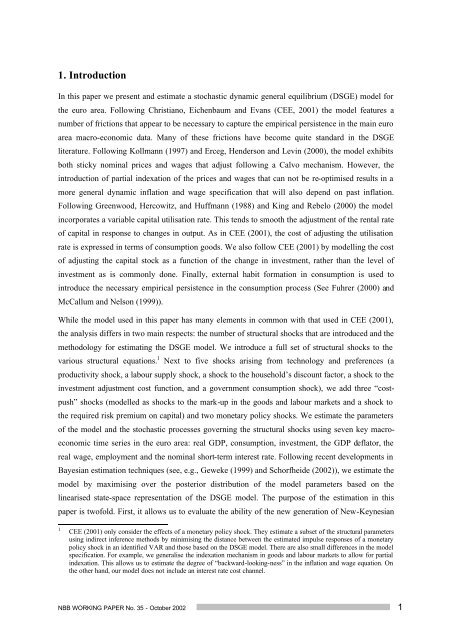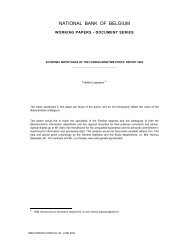An estimated dynamic stochastic general equilibrium model of the ...
An estimated dynamic stochastic general equilibrium model of the ...
An estimated dynamic stochastic general equilibrium model of the ...
You also want an ePaper? Increase the reach of your titles
YUMPU automatically turns print PDFs into web optimized ePapers that Google loves.
1. IntroductionIn this paper we present and estimate a <strong>stochastic</strong> <strong>dynamic</strong> <strong>general</strong> <strong>equilibrium</strong> (DSGE) <strong>model</strong> for<strong>the</strong> euro area. Following Christiano, Eichenbaum and Evans (CEE, 2001) <strong>the</strong> <strong>model</strong> features anumber <strong>of</strong> frictions that appear to be necessary to capture <strong>the</strong> empirical persistence in <strong>the</strong> main euroarea macro-economic data. Many <strong>of</strong> <strong>the</strong>se frictions have become quite standard in <strong>the</strong> DSGEliterature. Following Kollmann (1997) and Erceg, Henderson and Levin (2000), <strong>the</strong> <strong>model</strong> exhibitsboth sticky nominal prices and wages that adjust following a Calvo mechanism. However, <strong>the</strong>introduction <strong>of</strong> partial indexation <strong>of</strong> <strong>the</strong> prices and wages that can not be re-optimised results in amore <strong>general</strong> <strong>dynamic</strong> inflation and wage specification that will also depend on past inflation.Following Greenwood, Hercowitz, and Huffmann (1988) and King and Rebelo (2000) <strong>the</strong> <strong>model</strong>incorporates a variable capital utilisation rate. This tends to smooth <strong>the</strong> adjustment <strong>of</strong> <strong>the</strong> rental rate<strong>of</strong> capital in response to changes in output. As in CEE (2001), <strong>the</strong> cost <strong>of</strong> adjusting <strong>the</strong> utilisationrate is expressed in terms <strong>of</strong> consumption goods. We also follow CEE (2001) by <strong>model</strong>ling <strong>the</strong> cost<strong>of</strong> adjusting <strong>the</strong> capital stock as a function <strong>of</strong> <strong>the</strong> change in investment, ra<strong>the</strong>r than <strong>the</strong> level <strong>of</strong>investment as is commonly done. Finally, external habit formation in consumption is used tointroduce <strong>the</strong> necessary empirical persistence in <strong>the</strong> consumption process (See Fuhrer (2000) andMcCallum and Nelson (1999)).While <strong>the</strong> <strong>model</strong> used in this paper has many elements in common with that used in CEE (2001),<strong>the</strong> analysis differs in two main respects: <strong>the</strong> number <strong>of</strong> structural shocks that are introduced and <strong>the</strong>methodology for estimating <strong>the</strong> DSGE <strong>model</strong>. We introduce a full set <strong>of</strong> structural shocks to <strong>the</strong>various structural equations. 1 Next to five shocks arising from technology and preferences (aproductivity shock, a labour supply shock, a shock to <strong>the</strong> household’s discount factor, a shock to <strong>the</strong>investment adjustment cost function, and a government consumption shock), we add three “costpush”shocks (<strong>model</strong>led as shocks to <strong>the</strong> mark-up in <strong>the</strong> goods and labour markets and a shock to<strong>the</strong> required risk premium on capital) and two monetary policy shocks. We estimate <strong>the</strong> parameters<strong>of</strong> <strong>the</strong> <strong>model</strong> and <strong>the</strong> <strong>stochastic</strong> processes governing <strong>the</strong> structural shocks using seven key macroeconomictime series in <strong>the</strong> euro area: real GDP, consumption, investment, <strong>the</strong> GDP deflator, <strong>the</strong>real wage, employment and <strong>the</strong> nominal short-term interest rate. Following recent developments inBayesian estimation techniques (see, e.g., Geweke (1999) and Schorfheide (2002)), we estimate <strong>the</strong><strong>model</strong> by maximising over <strong>the</strong> posterior distribution <strong>of</strong> <strong>the</strong> <strong>model</strong> parameters based on <strong>the</strong>linearised state-space representation <strong>of</strong> <strong>the</strong> DSGE <strong>model</strong>. The purpose <strong>of</strong> <strong>the</strong> estimation in thispaper is tw<strong>of</strong>old. First, it allows us to evaluate <strong>the</strong> ability <strong>of</strong> <strong>the</strong> new generation <strong>of</strong> New-Keynesian1CEE (2001) only consider <strong>the</strong> effects <strong>of</strong> a monetary policy shock. They estimate a subset <strong>of</strong> <strong>the</strong> structural parametersusing indirect inference methods by minimising <strong>the</strong> distance between <strong>the</strong> <strong>estimated</strong> impulse responses <strong>of</strong> a monetarypolicy shock in an identified VAR and those based on <strong>the</strong> DSGE <strong>model</strong>. There are also small differences in <strong>the</strong> <strong>model</strong>specification. For example, we <strong>general</strong>ise <strong>the</strong> indexation mechanism in goods and labour markets to allow for partialindexation. This allows us to estimate <strong>the</strong> degree <strong>of</strong> “backward-looking-ness” in <strong>the</strong> inflation and wage equation. On<strong>the</strong> o<strong>the</strong>r hand, our <strong>model</strong> does not include an interest rate cost channel.NBB WORKING PAPER No. 35 - October 2002 1
















